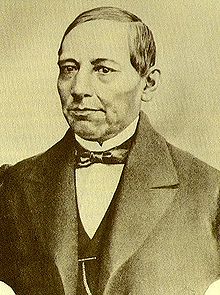出生地瓦哈卡州的格言:尊重其他人權益就是和平,為 胡亞雷斯的嘉言。
Cerro de San Felipe, Benito Juárez National Park
*****
When moderate liberal President
Ignacio Comonfort was forced to resign by the
Conservatives in 1858, Juárez, as head of the
Supreme Court, assumed the presidency following the succession codified in the
Constitution of 1857. He weathered the
War of the Reform (1858–60), a civil war between the Liberals and the Conservatives, and then the
French invasion (1861–1867), which was supported by Conservative monarchists. Never relinquishing office although forced into exile to areas of Mexico not controlled by the French, Juárez tied Liberalism to Mexican nationalism and maintained that he was the legitimate head of the Mexican state, rather than
Emperor Maximilian. When the French-backed
Second Mexican Empire fell in 1867, the Mexican Republic with Juárez as president was restored to full power.
[5][6][7] For his success in ousting the European incursion, Latin Americans considered his time in power as a "second struggle for independence, a second defeat for the European powers, and a second reversal of the Conquest."
[8]
Juárez is now revered in Mexico as "a preeminent symbol of Mexican nationalism and resistance to foreign intervention."
[9] Juárez was a practical and skilled politician, controversial in his lifetime and beyond. He had an understanding of the importance of a working relationship with the United States, and secured its recognition for his liberal government during the War of the Reform. Although many of his positions shifted during his political life, he held fast to particular principles including the supremacy of civil power over the Catholic Church and part of the military; respect for law; and the de-personalization of political life.
[10] In his lifetime he sought to strengthen the national government and asserted the supremacy of central power over states, a position that both radical and provincial liberals opposed.
[11] He was the subject of polemical attacks both in his lifetime and beyond. However, the place of Juárez in Mexican historical memory has enshrined him as a major Mexican hero, beginning in his own lifetime.
[12]
His birthday (March 21) is a national
public and
patriotic holiday in Mexico. He is the only individual Mexican so honored.
胡亞雷斯傳 北京:商務,1983







沒有留言:
張貼留言